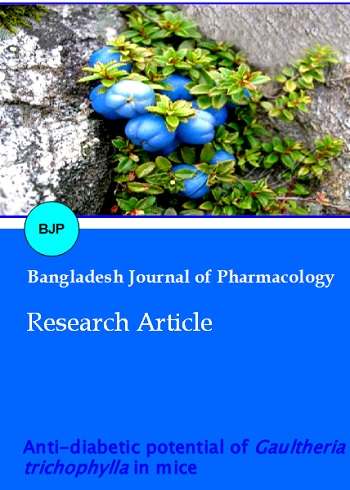Antidiabetic potential of Gaultheria trichophylla in mice
DOI:
https://doi.org/10.3329/bjp.v12i3.32512Keywords:
Antidiabetic, Cholesterol, Gaultheria trichophylla, ?-Glucosidase inhibitorAbstract
This study evaluated Gaultheria trichophylla for its in vitro and in vivo anti-diabetic activity and its effect on biochemical parameters. The extract inhibited ?-glucosidase with IC50 = 17.5 ± 0.1 ?g/mL). The difference of body weight of the extract-treated diabetic groups and diabetic control was significant (p<0.05). The extract-treated and the standard-treated groups showed significant (p<0.001) decrease in the fasting blood glucose levels compared to diabetic control. The extract-treated groups after 15 days of treatment showed a significance (p<0.001 and p<0.05) decrease of the urea and creatinine levels respectively. The extract and standard-treated diabetic groups showed a significant decreased in the serum level of cholesterol, LDL, and triglycerides compared to the diabetic control group (p<0.001). The extract and standard drug showed a significance improvement of HDL level in diabetic mice compared to the diabetic control (p<0.001).
Video Clip of Methodology:
2 min 49 sec: Full Screen Alternate
Downloads
157
119 Read
22

Published
How to Cite
Issue
Section
License
Authors who publish with this journal agree to the following terms:
- Authors retain copyright and grant the journal right of first publication with the work simultaneously licensed under a Creative Commons Attribution License that allows others to share the work with an acknowledgement of the work's authorship and initial publication in this journal.
- Authors are able to enter into separate, additional contractual arrangements for the non-exclusive distribution of the journal's published version of the work (e.g., post it to an institutional repository or publish it in a book), with an acknowledgement of its initial publication in this journal.
- Authors are permitted and encouraged to post their work online (e.g., in institutional repositories or on their website) prior to and during the submission process, as it can lead to productive exchanges, as well as earlier and greater citation of published work (See The Effect of Open Access).
